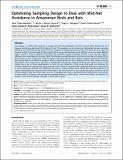Files in this item
Optimizing sampling design to deal with mist-net avoidance in Amazonian birds and bats
Item metadata
| dc.contributor.author | Marques, Joao Tiago | |
| dc.contributor.author | Ramos Pereira, Maria J. | |
| dc.contributor.author | Marques, Tiago A. | |
| dc.contributor.author | Santos, Carlos David | |
| dc.contributor.author | Santana, Joana | |
| dc.contributor.author | Beja, Pedro | |
| dc.contributor.author | Palmeirim, Jorge M. | |
| dc.date.accessioned | 2014-03-12T16:01:03Z | |
| dc.date.available | 2014-03-12T16:01:03Z | |
| dc.date.issued | 2013-09-18 | |
| dc.identifier | 99506992 | |
| dc.identifier | ab950ba9-e3d4-4a85-ad75-3f0d634545e4 | |
| dc.identifier | 000324695900050 | |
| dc.identifier | 84884252661 | |
| dc.identifier.citation | Marques , J T , Ramos Pereira , M J , Marques , T A , Santos , C D , Santana , J , Beja , P & Palmeirim , J M 2013 , ' Optimizing sampling design to deal with mist-net avoidance in Amazonian birds and bats ' , PLoS One , vol. 8 , no. 9 , 74505 . https://doi.org/10.1371/journal.pone.0074505 | en |
| dc.identifier.issn | 1932-6203 | |
| dc.identifier.other | ORCID: /0000-0002-2581-1972/work/56861290 | |
| dc.identifier.uri | https://hdl.handle.net/10023/4520 | |
| dc.description.abstract | Mist netting is a widely used technique to sample bird and bat assemblages. However, captures often decline with time because animals learn and avoid the locations of nets. This avoidance or net shyness can substantially decrease sampling efficiency. We quantified the day-to-day decline in captures of Amazonian birds and bats with mist nets set at the same location for four consecutive days. We also evaluated how net avoidance influences the efficiency of surveys under different logistic scenarios using re-sampling techniques. Net avoidance caused substantial declines in bird and bat captures, although more accentuated in the latter. Most of the decline occurred between the first and second days of netting: 28% in birds and 47% in bats. Captures of commoner species were more affected. The numbers of species detected also declined. Moving nets daily to minimize the avoidance effect increased captures by 30% in birds and 70% in bats. However, moving the location of nets may cause a reduction in netting time and captures. When moving the nets caused the loss of one netting day it was no longer advantageous to move the nets frequently. In bird surveys that could even decrease the number of individuals captured and species detected. Net avoidance can greatly affect sampling efficiency but adjustments in survey design can minimize this. Whenever nets can be moved without losing netting time and the objective is to capture many individuals, they should be moved daily. If the main objective is to survey species present then nets should still be moved for bats, but not for birds. However, if relocating nets causes a significant loss of netting time, moving them to reduce effects of shyness will not improve sampling efficiency in either group. Overall, our findings can improve the design of mist netting sampling strategies in other tropical areas. | |
| dc.format.extent | 8 | |
| dc.format.extent | 397664 | |
| dc.language.iso | eng | |
| dc.relation.ispartof | PLoS One | en |
| dc.subject | Vertical stratification | en |
| dc.subject | Insectivorous bats | en |
| dc.subject | Species richness | en |
| dc.subject | Forest | en |
| dc.subject | Population | en |
| dc.subject | Vegetation | en |
| dc.subject | Abundance | en |
| dc.subject | Habitats | en |
| dc.title | Optimizing sampling design to deal with mist-net avoidance in Amazonian birds and bats | en |
| dc.type | Journal article | en |
| dc.contributor.institution | University of St Andrews. School of Mathematics and Statistics | en |
| dc.contributor.institution | University of St Andrews. Scottish Oceans Institute | en |
| dc.contributor.institution | University of St Andrews. Centre for Research into Ecological & Environmental Modelling | en |
| dc.identifier.doi | 10.1371/journal.pone.0074505 | |
| dc.description.status | Peer reviewed | en |
This item appears in the following Collection(s)
Items in the St Andrews Research Repository are protected by copyright, with all rights reserved, unless otherwise indicated.

